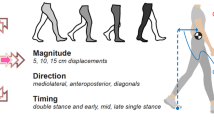Abstract
Running, walking, flying and swimming are all processes in which animals produce propulsion by executing rhythmic motions of their bodies. Dynamical stability of the locomotion is hardly automatic: millions of older people are injured by falling each year. Stability frequently requires sensory feedback. We investigate how organisms obtain the information they use in maintaining their stability. Assessing stability of a periodic orbit of a dynamical system requires information about the dynamics of the system off the orbit. For locomotion driven by a periodic orbit, perturbations that “kick” the trajectory off the orbit must occur in order to observe convergence rates toward the orbit. We propose that organisms generate excitations in order to set the gains for stabilizing feedback. We hypothesize further that these excitations are stochastic but have heavy-tailed, non-Gaussian probability distributions. Compared to Gaussian distributions, we argue that these are more effective for estimating stability characteristics of the orbit. Finally, we propose experiments to test the efficacy of these ideas.











Similar content being viewed by others
Notes
The vector fields are discontinuous at impacts, and their dimension may change due to different numbers of ground contacts. A slightly larger model would also describe the motion of the COM, but the periodic orbit would be replaced by a trajectory that undergoes a fixed horizontal translation each step.
The RMSE is the \(L^2\) error over the probability space of realizations. Its square has the appealing property of being the variance plus the square bias of the estimator. We use the RMSE of Floquet exponent estimates, as opposed to estimates of the Floquet multiplier, because the former has better invariance properties. In particular, the value of the exponent is the same when computed from trajectories which make different numbers of circuits around a periodic orbit. To simulate the expectation, \(10^3\) realizations are used.
In this example and the last, the intersections of the numerical solution with the cross section of interest are approximated with cubic Hermite splines. Doing so is unnecessary in the van der Pol setting—a linear interpolant is sufficiently accurate. However, that is not the case for the perturbed Lorenz system studied here (time step \(\varDelta t = 2 \times 10^{-4}\)).
References
Blickhan R, Full RJ (1993) Similarity in multilegged locomotion: bouncing like a monopode. J Comp Physiol A 173(5):509–517. https://doi.org/10.1007/BF00197760
Brockwell PJ, Davis RA (1991) Time series: theory and methods, 2nd edn. Springer, New York. https://doi.org/10.1007/978-1-4419-0320-4
Cabrera JL, Milton JG (2004a) Human stick balancing: tuning Lévy flights to improve balance control. Chaos 14(3):691–698. https://doi.org/10.1063/1.1785453
Cabrera JL, Milton JG (2004b) Stick balancing: on-off intermittency and survival times. Nonlinear Stud 11(3):305–318
Collins JJ, De Luca CJ (1993) Open-loop and closed-loop control of posture: a random-walk analysis of center-of-pressure trajectories. Exp Brain Res 95(2):308–318. https://doi.org/10.1007/BF00229788
Collins JJ, De Luca CJ (1994) Random walking during quiet standing. Phys Rev Lett 73(5):764–767. https://doi.org/10.1103/PhysRevLett.73.764
Grassberger P, Procaccia I (1983) Characterization of strange attractors. Phys Rev Lett 50(5):346–349. https://doi.org/10.1103/PhysRevLett.50.346
Guckenheimer J (1995) A robust hybrid stabilization strategy for equilibria. IEEE Trans Automat Control 40(2):321–326. https://doi.org/10.1109/9.341802
Guckenheimer J (2014) From data to dynamical systems. Nonlinearity 27(7):R41. https://doi.org/10.1088/0951-7715/27/7/R41
Hamilton JD (1994) Time series analysis. Princeton University Press, Princeton
Hannan EJ, Kanter M (1977) Autoregressive processes with infinite variance. J Appl Probab 14(2):411–415. https://doi.org/10.2307/3213015
Hartman P (2002) Ordinary differential equations, 2nd edn. Society for Industrial and Applied Mathematics, Philadelphia, corrected reprint of the second (1982) edition. https://doi.org/10.1137/1.9780898719222
Holmes P, Full RJ, Koditschek D, Guckenheimer J (2006) The dynamics of legged locomotion: models, analyses, and challenges. SIAM Rev 48(2):207–304. https://doi.org/10.1137/S0036144504445133
Javeed A (2017) An uncertainty principle for estimates of Floquet multipliers. arXiv:1711.10992
Lehmann EL, Casella G (1998) Theory of point estimation, 2nd edn. Springer, New York. https://doi.org/10.1007/b98854
Maus HM, Revzen S, Guckenheimer J, Ludwig C, Reger J, Seyfarth A (2015) Constructing predictive models of human running. J R Soc Interface. https://doi.org/10.1098/rsif.2014.0899
Peterka RJ (2000) Postural control model interpretation of stabilogram diffusion analysis. Biol Cybern 82(4):335–343. https://doi.org/10.1007/s004220050587
Revzen S, Guckenheimer JM (2008) Estimating the phase of synchronized oscillators. Phys Rev E 78:051907. https://doi.org/10.1103/PhysRevE.78.051907
Ristroph L, Bergou AJ, Ristroph G, Coumes K, Berman GJ, Guckenheimer J, Wang ZJ, Cohen I (2010) Discovering the flight autostabilizer of fruit flies by inducing aerial stumbles. Proc Natl Acad Sci USA 107(11):4820–4824. https://doi.org/10.1073/pnas.1000615107
Schaal S, Sternad D, Atkeson CG (1996) One-handed juggling: a dynamical approach to a rhythmic movement task. J Mot Behav 28(2):165–183. https://doi.org/10.1080/00222895.1996.9941743
Sussmann HJ (1978) On the gap between deterministic and stochastic ordinary differential equations. Ann Probab 6(1):19–41. https://doi.org/10.1214/aop/1176995608
Author information
Authors and Affiliations
Corresponding author
Additional information
Communicated by Benjamin Lindner.
This article belongs to the Special Issue on Control Theory in Biology and Medicine. It derived from a workshop at the Mathematical Biosciences Institute, Ohio State University, Columbus, OH, USA.
Rights and permissions
About this article
Cite this article
Guckenheimer, J., Javeed, A. Locomotion: exploiting noise for state estimation. Biol Cybern 113, 93–104 (2019). https://doi.org/10.1007/s00422-018-0772-z
Received:
Accepted:
Published:
Issue Date:
DOI: https://doi.org/10.1007/s00422-018-0772-z




